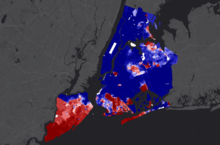Contents
| Year | Democratic | Republican | |||
|---|---|---|---|---|---|
| 2020 | 76.19% | 2,321,759 | 22.70% | 691,682 | |
| 2016 | 79.95% | 2,191,869 | 17.04% | 467,254 | |
| 2012 | 81.19% | 1,995,241 | 17.78% | 436,889 | |
| 2008 | 79.29% | 2,074,159 | 20.06% | 524,787 | |
| 2004 | 74.99% | 1,828,015 | 24.10% | 587,534 | |
| 2000 | 77.90% | 1,703,364 | 18.23% | 398,726 | |
| 1996 | 77.10% | 1,512,248 | 17.31% | 339,537 | |
| 1992 | 68.72% | 1,458,784 | 24.00% | 509,423 | |
| 1988 | 66.17% | 1,340,795 | 32.84% | 665,407 | |
| 1984 | 60.96% | 1,343,875 | 38.66% | 852,317 | |
| 1980 | 54.88% | 1,052,178 | 37.51% | 719,278 | |
| 1976 | 66.37% | 1,423,380 | 32.95% | 706,663 | |
| 1972 | 51.46% | 1,342,996 | 48.27% | 1,259,873 | |
| 1968 | 60.56% | 1,582,681 | 33.94% | 886,959 | |
| 1964 | 73.02% | 2,183,646 | 26.81% | 801,877 | |
| 1960 | 62.62% | 1,936,323 | 37.04% | 1,145,205 | |
| 1956 | 51.10% | 1,617,701 | 48.90% | 1,548,132 | |
| 1952 | 54.54% | 1,861,930 | 43.79% | 1,495,493 | |
| 1948 | 49.47% | 1,596,545 | 34.34% | 1,108,288 | |
| 1944 | 61.64% | 2,042,500 | 38.36% | 1,271,287 | |
| 1940 | 61.18% | 1,966,083 | 38.82% | 1,247,624 | |
| 1936 | 75.40% | 2,041,347 | 24.60% | 665,951 | |
| 1932 | 67.31% | 1,455,176 | 27.02% | 584,056 | |
| 1928 | 62.06% | 1,167,971 | 37.94% | 714,144 | |
| 1924 | 35.02% | 489,199 | 44.83% | 626,131 | |
| 1920 | 27.34% | 345,001 | 62.29% | 785,947 | |
| 1916 | 52.95% | 353,235 | 47.05% | 313,813 | |
| 1912 | 49.76% | 312,386 | 20.16% | 126,582 | |
| 1908 | 48.52% | 284,190 | 51.48% | 301,568 | |
| 1904 | 53.05% | 326,900 | 46.95% | 289,345 | |
| 1900 | 52.47% | 309,524 | 47.53% | 280,343 | |
Since its creation in 1898, New York City has been a stronghold of the Democratic Party through the use of machine-style politics. The city as a whole has only been carried by a Republican in three presidential elections that being William Howard Taft in 1908, Warren G. Harding in 1920, and President Calvin Coolidge in 1924. The boroughs of Manhattan and Bronx were only carried by a Republican in 1920 and 1924. Brooklyn was carried by a Republican just six times (1896 through 1908, 1920, and 1924), while Queens has been carried by a Republican on the presidential level once since 1960 (in 1972). Meanwhile, Staten Island remains strongly Republican having been carried by a Democrat four times since 1940 (in 1964, 1996, 2000, and 2012).
As of 2024, New York City is split between 14 of the state's 26 congressional districts, covering the 3rd through 16th congressional districts. All but one are held by Democrats, the only exception is the Staten Island-based 11th district. Due almost entirely to the Democrats' near-total dominance at the local level, the Democrats have held a majority of the state's congressional seats since 1965.
Historically, the most conservative district in the city is that based in Staten Island and southern Brooklyn; until 2013 called New York's 13th congressional district. The district has been a reliably red bastion in a deep blue city, sending a Republican to Congress in every election since 1980 except 2008 and 2018. With former city councilman Michael McMahon's 2008 election victory in the district, Democrats took all of the city's congressional seats for the first time in 76 years. The status would be short-lived as Republican Michael Grimm defeated McMahon 2 years later to retake the seat in the 2010 midterms. Renamed in 2013 as New York's 11th congressional district, the seat would flip once more when Democrat Max Rose unseated Republican incumbent Dan Donovan in the 2018 midterm election. However, Democratic gain in the district proved ephemeral yet again. In the 2020 election, Republican Assemblywoman Nicole Malliotakis has reclaimed the GOP's sole House seat in New York City, again defeating a freshman Democratic incumbent, by a margin of 53% to 47%.[3][4]
Following the 2020 census, New York's 3rd district, which is primarily located in Nassau County, was redrawn to include portions of northeast Queens. In the subsequent 2022 election, George Santos defeated Robert Zimmerman to become the district's representative, joining Malliotakis as the only other Republican to represent any of the five boroughs in Congress.[5] However, Santos was expelled and replaced by Democrat Tom Suozzi in February 2024.

Political influence
The Flushing Remonstrance signed by colonists in 1657 is considered a precursor to the United States Constitution's provision on freedom of religion in the Bill of Rights. The signers protested the Dutch colonial authorities' persecution of Quakers in what is today the borough of Queens.

New York City politicians often exert influence outside the city in response to the city's diverse ethnic constituencies. For example, in 1984 the New York City Comptroller’s Office under the direction of then-Comptroller Harrison J. Goldin developed with Irish Nobel Peace laureate Seán MacBride the MacBride Principles, which call on companies operating in Northern Ireland to increase employment opportunities for members of underrepresented religious groups, ban the display of provocative sectarian emblems in the workplace, promote security for minority employees and abolish hiring criteria that discriminate based on religion or ethnicity. A 2006 report by the New York City Comptroller's Office found that 88 US and Canadian corporations operating in Northern Ireland had agreed to independent monitoring of their compliance with the MacBride Principles.[6]
Four of the top five zip codes in the United States for political contributions are in Manhattan. The top zip code, 10021 on the Upper East Side, generated the most money for the 2004 presidential campaigns of both George W. Bush and John Kerry.[7]
Operations
In 2008, New York City and London announced the Innovation Exchange Programme, in which the two cities will share best practices in government innovation. The program involves not only the formal exchange of ideas but also the transfer of personnel between the cities. It will focus on transparency and accountability, efficiency, transport, policy, education and skills, and environmental policy.[8]
References
- ^ "New York Election Results". David Leip. Retrieved January 31, 2018.
- ^ "Statement and Return Report for Certification General Election 2020" (PDF). Retrieved December 1, 2020.
- ^ "BOARD OF ELECTIONS IN THE CITY OF NEW YORK 2020 ELECTION NIGHT RESULTS Representative in Congress, 11th Congressional District". Retrieved November 6, 2020.
- ^ "New York State Board of Elections, 2020 General Election Night Results". Retrieved November 6, 2020.
- ^ "George Santos wins New York's 3rd Congressional District versus Robert Zimmerman". FOX 5 NY. 2022-11-09. Retrieved 2023-06-15.
- ^ Office of the New York City Comptroller (November 2006). "The MacBride Principles and Fair Employment Practices in Northern Ireland" (PDF). Archived from the original (PDF) on 2006-11-30. Retrieved 2006-11-14.
- ^ Opensecrets.org (2005-05-16). "2006 Election Overview: Top Zip codes". Archived from the original on 2006-03-02. Retrieved 2006-07-19.
- ^ The London New York Dialogue (July 2008). "London and New York in the 21st Century. New Competition and New Opportunities: can London and New York still be the leading world cities in 2100?" (PDF). Retrieved 2008-08-11.

